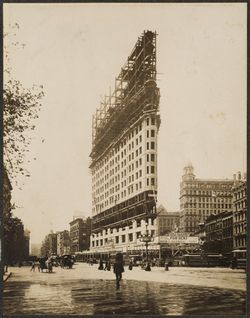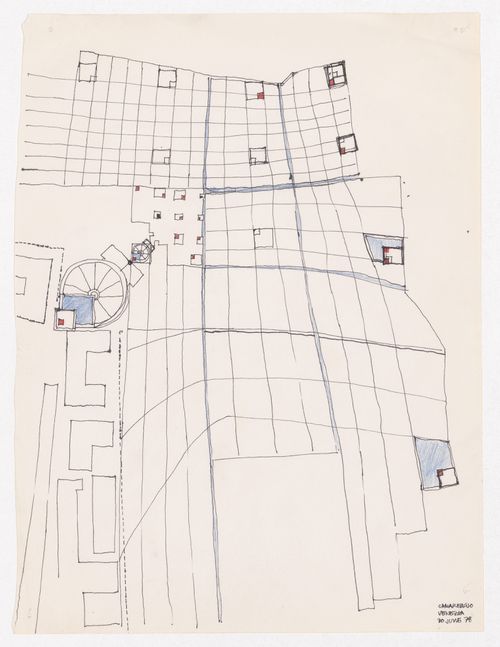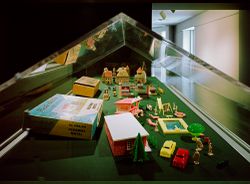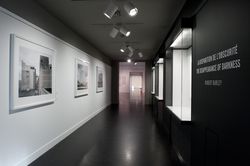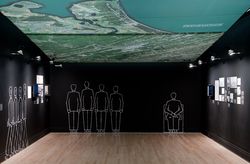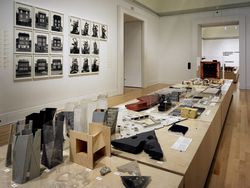textual records
DR2021:0052:001-039
Description:
The papers in this collection are related to the participation of Barry Campbell in a project to create a 1:50 scale model for the Maison d'Artiste, an unbuilt project designed by architects Theo van Doesburg and Cor van Eesteren in 1923. The model, sponsored by lawyer Piet Sanders and Barry Campbell, was made by Frans Postma and was exhibited at the Stedelijk Museum De Lakenhal (2009-2010) and the Tate Modern (2010) as part of the exhibition "Van Doesburg and the International Avant Garde: Constructing a New World". In 2013, Barry Campbell, Frans Postma and Victor Veldhuijzen van Zanten donated the 1:50 model to Het Nieuwe Instituut/The New Institute in Rotterdam, the Netherlands (Piet Sanders, who died in September, 2012, was also named as a donor). A 1:75 scale model was made for each of the donors. Textual records in the collection include correspondence, a copy of the donor agreement, and a text by Bertus Mulder. Drawings include printouts of plans, elevations, sections, and perspectives. There are also photographs of drawings. Digital files consist of a panorama by Postma & Partner. The collection includes a printout of a photograph of Barry Campbell with the 1:50 model.
2007-2013
Barry Campbell papers related to a 1:50 scale model for the Maison d'Artiste
Actions:
DR2021:0052:001-039
Description:
The papers in this collection are related to the participation of Barry Campbell in a project to create a 1:50 scale model for the Maison d'Artiste, an unbuilt project designed by architects Theo van Doesburg and Cor van Eesteren in 1923. The model, sponsored by lawyer Piet Sanders and Barry Campbell, was made by Frans Postma and was exhibited at the Stedelijk Museum De Lakenhal (2009-2010) and the Tate Modern (2010) as part of the exhibition "Van Doesburg and the International Avant Garde: Constructing a New World". In 2013, Barry Campbell, Frans Postma and Victor Veldhuijzen van Zanten donated the 1:50 model to Het Nieuwe Instituut/The New Institute in Rotterdam, the Netherlands (Piet Sanders, who died in September, 2012, was also named as a donor). A 1:75 scale model was made for each of the donors. Textual records in the collection include correspondence, a copy of the donor agreement, and a text by Bertus Mulder. Drawings include printouts of plans, elevations, sections, and perspectives. There are also photographs of drawings. Digital files consist of a panorama by Postma & Partner. The collection includes a printout of a photograph of Barry Campbell with the 1:50 model.
textual records
2007-2013
Scaled map of the coast of France, with locations of major cities in France and western Europe
DR1974:0002:001:002
topographic
1822
Scaled map of the coast of France, with locations of major cities in France and western Europe
Actions:
DR1974:0002:001:002
topographic
Architects of the Image: Photography in the Heroic Age of Construction explores the relationships between camera images and the making of large-scale architectural and engineering structures that stirred public imagination in the first hundred years of photography. The exhibition is predicated on the notion of the photographer as architect, an analogy that suggests(...)
11 October 1995 to 4 February 1996
Architects of the Image: Photography in the Heroic Age of Construction
Actions:
Description:
Architects of the Image: Photography in the Heroic Age of Construction explores the relationships between camera images and the making of large-scale architectural and engineering structures that stirred public imagination in the first hundred years of photography. The exhibition is predicated on the notion of the photographer as architect, an analogy that suggests(...)
DR1991:0017:001
Description:
site plan
1978
Sketch site plan with plan of S. Simeone Piccolo church at two different scales and deformed grid of houses for International Seminary of Design in the Area of Cannaregio-West, Venice, Italy
Actions:
DR1991:0017:001
Description:
site plan
Not only do toys provide evidence of the social and economic life of their period, but architectural toys ranging from wooden building blocks to iron and steel construction sets reflect distinct stylistic predilections and technological advances. New industrial and building techniques were used not only to create the new building types transforming our cities, but were(...)
Octagonal gallery
28 November 1990 to 31 March 1991
Buildings in Boxes: Architectural Toys from the CCA
Actions:
Description:
Not only do toys provide evidence of the social and economic life of their period, but architectural toys ranging from wooden building blocks to iron and steel construction sets reflect distinct stylistic predilections and technological advances. New industrial and building techniques were used not only to create the new building types transforming our cities, but were(...)
Octagonal gallery
The exhibition Robert Burley: The Disappearance of Darkness presents a series of photographs by Canadian artist Robert Burley, documenting the decline of traditional photographic equipment manufacturing brought on by new technologies. Since 2005, digital photographic technology has increasingly displaced its analog predecessor, resulting in a plummeting demand for(...)
Hall cases
11 September 2009 to 15 November 2009
Robert Burley: The Disappearance of Darkness
Actions:
Description:
The exhibition Robert Burley: The Disappearance of Darkness presents a series of photographs by Canadian artist Robert Burley, documenting the decline of traditional photographic equipment manufacturing brought on by new technologies. Since 2005, digital photographic technology has increasingly displaced its analog predecessor, resulting in a plummeting demand for(...)
Hall cases
The armies of World War Two represented only the tips of colliding icebergs, the belligerent nations which had mobilized and transformed themselves for a global “war of production” of unprecedented scale. Architecture in Uniform: Designing and Building for the Second World War documents the extensive contribution of architecture to the war between the bombings of Guernica(...)
Main galleries
13 April 2011 to 18 September 2011
Architecture in Uniform: Designing and Building for the Second World War
Actions:
Description:
The armies of World War Two represented only the tips of colliding icebergs, the belligerent nations which had mobilized and transformed themselves for a global “war of production” of unprecedented scale. Architecture in Uniform: Designing and Building for the Second World War documents the extensive contribution of architecture to the war between the bombings of Guernica(...)
Main galleries
PH1979:0508
Description:
This album depicts photographs, plans, sketches of Stonehenge and texts. Preface is signed by Sir Henry James, 29th May 1867, Southhampton. Album has appendix and List of Books inserted at the end. "Col. Sir Henry James, Director-General of the Ordnance Survey, was a strong believer that photography had to be utilized as a major tool for mapping and survey work and he employed the Royal Engineers for that purpose. Colonel James appears in several of the Stonehenge photographs published by the Ordnance Survey. [...] Stonehenge is the world's most famous, large megalithic stone circle and is usually designated as a site used for religious worship in Neolithic Britain. However, the first use of this locality for documented ritual activity goes back to the Mesolithic and the erection of several large totem poles perhaps as early as 8,000 BC (Stonehenge O). Lunar observations preceded the construction of a causeway c.3200 BC, followed by an earth circle and Heel Stones c.3100 BC (Stonehenge 1a) and the Aubrey Holes (Stonehenge 1b). The Stonehenge site was then abandoned for about 1,000 years when large bluestones quarried in Wales were brought to the site and made into the Double Bluestone Circle with Avenue. 2150 BC (Stonehenge II). Soon thereafter sarsen stones were brought in from Avebury to build the great Sarsen Circle and Trilithon Horseshoe, 2100 BC (Stonehenge IIIz). Bluestones were brought back and added as the Bluestone Circle and Bluestone Horseshoe to the sarsen monument, 1800 BC (Stonehenge IIId). The sacred avenue was extended to the River Avon, 1100 BC (Stonehenge IV), the last phase of megalithic construction at this site. Note that the great stone circle and all construction at the Stonehenge site was completed several hundred years before we can postulate Celtic druids in the vicinity. We can only mention in passing that Stonehenge was embedded within a large ritual complex, where several of the ten megalithic constructions were also monumental in scale. Integration between these structures may not have been well planned in advance, but assuredly was articulated as each was built." Neolithic Britian Online.
sculpture, topographic
1867
Plans and Photographs of Stonehenge, and of Turusachan in the Island of Lewis; with Notes Relating to the Druids and Sketches of Cromlechs in Ireland
Actions:
PH1979:0508
Description:
This album depicts photographs, plans, sketches of Stonehenge and texts. Preface is signed by Sir Henry James, 29th May 1867, Southhampton. Album has appendix and List of Books inserted at the end. "Col. Sir Henry James, Director-General of the Ordnance Survey, was a strong believer that photography had to be utilized as a major tool for mapping and survey work and he employed the Royal Engineers for that purpose. Colonel James appears in several of the Stonehenge photographs published by the Ordnance Survey. [...] Stonehenge is the world's most famous, large megalithic stone circle and is usually designated as a site used for religious worship in Neolithic Britain. However, the first use of this locality for documented ritual activity goes back to the Mesolithic and the erection of several large totem poles perhaps as early as 8,000 BC (Stonehenge O). Lunar observations preceded the construction of a causeway c.3200 BC, followed by an earth circle and Heel Stones c.3100 BC (Stonehenge 1a) and the Aubrey Holes (Stonehenge 1b). The Stonehenge site was then abandoned for about 1,000 years when large bluestones quarried in Wales were brought to the site and made into the Double Bluestone Circle with Avenue. 2150 BC (Stonehenge II). Soon thereafter sarsen stones were brought in from Avebury to build the great Sarsen Circle and Trilithon Horseshoe, 2100 BC (Stonehenge IIIz). Bluestones were brought back and added as the Bluestone Circle and Bluestone Horseshoe to the sarsen monument, 1800 BC (Stonehenge IIId). The sacred avenue was extended to the River Avon, 1100 BC (Stonehenge IV), the last phase of megalithic construction at this site. Note that the great stone circle and all construction at the Stonehenge site was completed several hundred years before we can postulate Celtic druids in the vicinity. We can only mention in passing that Stonehenge was embedded within a large ritual complex, where several of the ten megalithic constructions were also monumental in scale. Integration between these structures may not have been well planned in advance, but assuredly was articulated as each was built." Neolithic Britian Online.
1867
sculpture, topographic
Launched in November 1998 by the International Foundation for the Canadian Centre for Architecture, The CCA Competition for the Design of Cities invited architects from around the world to submit solutions to a problem facing all major cities at the dawn of the twenty-first century: how to repair the scars left by transportation structures that are vestiges from a bygone(...)
Main galleries
15 November 2000 to 1 April 2001
New York: CCA Competition for the Design of Cities
Actions:
Description:
Launched in November 1998 by the International Foundation for the Canadian Centre for Architecture, The CCA Competition for the Design of Cities invited architects from around the world to submit solutions to a problem facing all major cities at the dawn of the twenty-first century: how to repair the scars left by transportation structures that are vestiges from a bygone(...)
Main galleries
Herzog de Meuron: Archaeology of the Mind presents an exhaustive display of materials from the architects’ archive and from related collections. Referencing a natural history, the exhibition includes study models, books, photographs, toys, fossils, Chinese scholars’ rocks, and significant works of contemporary art, all of which have informed the thinking of the Swiss(...)
Main galleries
23 October 2002 to 6 April 2003
Herzog & de Meuron: Archaeology of the Mind
Actions:
Description:
Herzog de Meuron: Archaeology of the Mind presents an exhaustive display of materials from the architects’ archive and from related collections. Referencing a natural history, the exhibition includes study models, books, photographs, toys, fossils, Chinese scholars’ rocks, and significant works of contemporary art, all of which have informed the thinking of the Swiss(...)
Main galleries

